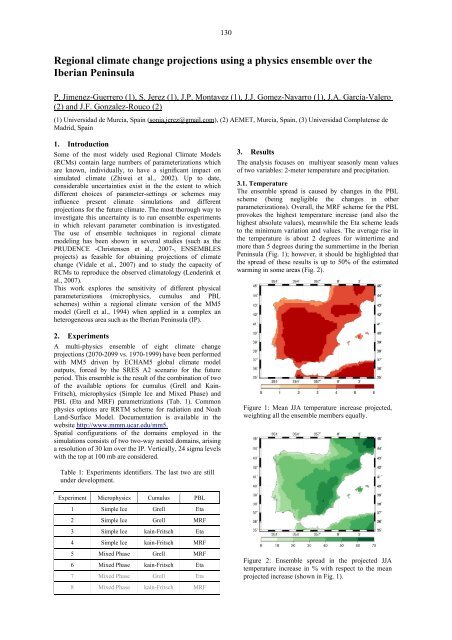Low (web) Quality - BALTEX
Low (web) Quality - BALTEX
Low (web) Quality - BALTEX
Create successful ePaper yourself
Turn your PDF publications into a flip-book with our unique Google optimized e-Paper software.
130<br />
Regional climate change projections using a physics ensemble over the<br />
Iberian Peninsula<br />
P. Jimenez-Guerrero (1), S. Jerez (1), J.P. Montavez (1), J.J. Gomez-Navarro (1), J.A. García-Valero<br />
(2) and J.F. Gonzalez-Rouco (2)<br />
(1) Universidad de Murcia, Spain (sonia.jerez@gmail.com), (2) AEMET, Murcia, Spain, (3) Universidad Complutense de<br />
Madrid, Spain<br />
1. Introduction<br />
Some of the most widely used Regional Climate Models<br />
(RCMs) contain large numbers of parameterizations which<br />
are known, individually, to have a significant impact on<br />
simulated climate (Zhiwei et al., 2002). Up to date,<br />
considerable uncertainties exist in the the extent to which<br />
different choices of parameter-settings or schemes may<br />
influence present climate simulations and different<br />
projections for the future climate. The most thorough way to<br />
investigate this uncertainty is to run ensemble experiments<br />
in which relevant parameter combination is investigated.<br />
The use of ensemble techniques in regional climate<br />
modeling has been shown in several studies (such as the<br />
PRUDENCE -Christensen et al., 2007-, ENSEMBLES<br />
projects) as feasible for obtaining projections of climate<br />
change (Vidale et al., 2007) and to study the capacity of<br />
RCMs to reproduce the observed climatology (Lenderink et<br />
al., 2007).<br />
This work explores the sensitivity of different physical<br />
parameterizations (microphysics, cumulus and PBL<br />
schemes) within a regional climate version of the MM5<br />
model (Grell et al., 1994) when applied in a complex an<br />
heterogeneous area such as the Iberian Peninsula (IP).<br />
2. Experiments<br />
A multi-physics ensemble of eight climate change<br />
projections (2070-2099 vs. 1970-1999) have been performed<br />
with MM5 driven by ECHAM5 global climate model<br />
outputs, forced by the SRES A2 scenario for the future<br />
period. This ensemble is the result of the combination of two<br />
of the available options for cumulus (Grell and Kain-<br />
Fritsch), microphysics (Simple Ice and Mixed Phase) and<br />
PBL (Eta and MRF) parametrizations (Tab. 1). Common<br />
physics options are RRTM scheme for radiation and Noah<br />
Land-Surface Model. Documentation is available in the<br />
<strong>web</strong>site http://www.mmm.ucar.edu/mm5.<br />
Spatial configurations of the domains employed in the<br />
simulations consists of two two-way nested domains, arising<br />
a resolution of 30 km over the IP. Vertically, 24 sigma levels<br />
with the top at 100 mb are considered.<br />
3. Results<br />
The analysis focuses on multiyear seasonly mean values<br />
of two variables: 2-meter temperature and precipitation.<br />
3.1. Temperature<br />
The ensemble spread is caused by changes in the PBL<br />
scheme (being negligible the changes in other<br />
parameterizations). Overall, the MRF scheme for the PBL<br />
provokes the highest temperature increase (and also the<br />
highest absolute values), meanwhile the Eta scheme leads<br />
to the minimum variation and values. The average rise in<br />
the temperature is about 2 degrees for wintertime and<br />
more than 5 degrees during the summertime in the Iberian<br />
Peninsula (Fig. 1); however, it should be highlighted that<br />
the spread of these results is up to 50% of the estimated<br />
warming in some areas (Fig. 2).<br />
Figure 1: Mean JJA temperature increase projected,<br />
weighting all the ensemble members equally.<br />
Table 1: Experiments identifiers. The last two are still<br />
under development.<br />
Experiment Microphysics Cumulus PBL<br />
1 Simple Ice Grell Eta<br />
2 Simple Ice Grell MRF<br />
3 Simple Ice kain-Fritsch Eta<br />
4 Simple Ice kain-Fritsch MRF<br />
5 Mixed Phase Grell MRF<br />
6 Mixed Phase kain-Fritsch Eta<br />
7 Mixed Phase Grell Eta<br />
8 Mixed Phase kain-Fritsch MRF<br />
Figure 2: Ensemble spread in the projected JJA<br />
temperature increase in % with respect to the mean<br />
projected increase (shown in Fig. 1).













